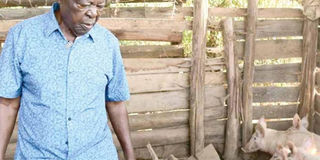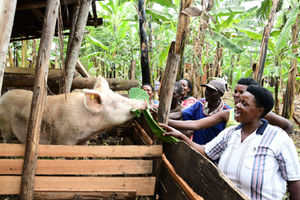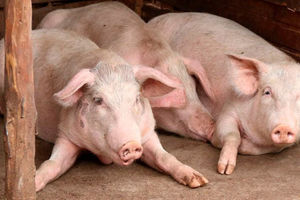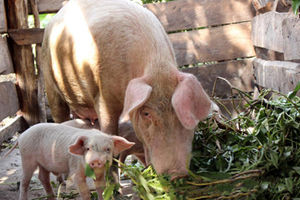
Canon Ezra Bataka, one of those who initially opposed to piggery on grounds that it would kill the cows, on his piggery. His Bataka Holdings Limited is now one of the biggest piggeries in Rukungiri. He has over 120 pigs but aims for at least 500.PHOTO/ABUBAKER LUBOWA
On the periphery of the grounds of the Rukungiri Pig Breeding Centre and Demonstration Farm, lies a simple gable roofed cattle shed made of timber and corrugated roofing sheets.
Inside the shed are about 40 dairy animals, some Friesians and others cross breeds of Friesians and local long-horned Ankole cattle.
The presence of the cows on the same grounds as hundreds of pigs is conspicuous in where pigs have always been believed to have a predatory effect on cows.
That belief is best captured by the remarks of Ms Jolly Twinamatsiko Kemiruka, a resident of Rushoroza A village in Rwerere Town Council, Rukungiri District.
“Our culture, we the Banyankole and Bahororo does not allow us to have pigs and cows at the same time. Dairy farming and piggery do not go together. It was believed that cows would die if they were on the same compound with pigs,” she says.
Ms Kemiruka is the chairperson of Rwerere Women Entrepreneurs Group, one of the many women’s groups and Savings and Credit Cooperatives Societies and Organisations (Saccos) in Kigezi region that have in recent times taken to piggery thanks to a sustained campaign carried out by the Rukungiri Producer Cooperative Union (RPCU) with funding from the Microfinance Support Centre (MSC).
The cooperative and MSC signed an MoU that came into force in September 22, 2021, under which the former run and operate a pig breeding centre and demonstration farm and the latter the funding for promotion of piggery by providing training and outreach services for beneficiary groups.
New science
Dr Sam Akankwasa, the founder and chairman of RPCU, says that the initial idea was to use manure from the pigs to help the soils in the region regain their fertility and also boost household incomes in line with government poverty alleviation and financial inclusion campaign.
“I told our people that we can raise pigs as a source of income, but also use them to help our soils to regain their fertility” he says.
The results have been good so far and now Dr Akankwasa says that a new science has emerged – that one needs dairy cattle if they are to become successful in the area of piggery.
“I now want to teach people that you cannot have pigs properly without having at least one cow. This is a new science,” he says.
Milk for pigs
In what would appear like a repeat of Chapter III of George Orwell’s book, “Animal Farm”, when the animals discover that the pigs have been taking all the milk and apples for themselves forcing Squealer to explain that “the pigs need the milk and apples in order to thing well”, it is emerging that the pigs actually do need the milk. “For you to have pigs, you must have milk to feed those piglets”, Dr Akankwasa says.
That finding, he says, was arrived at out of research that was fortuitously carried out on the pig breeding centre and demonstration farm. It was precipitated by the death of two sows that left tens of piglets.
“The piglets were fed on milk from the cows and none of them died,” Dr Akankwasa says.
Since then, he says, it has become a best practice on the breeding centre and demonstration farm to feed piglets on milk.
That was driven by subsequent discoveries that fallowing pigs never generate enough milk to feed their piglets, which makes it necessary to supplement their milk with milk from cows. And the required amounts for both pigs and piglets are surprisingly small.
“In a day even if it gets a quarter of a half-litre (125 millilitres), not a litre, not a half of a litre, but a quarter of it, can sustain a very huge,” he says. The piglets require even smaller amounts.
“If you get a piglet and give them a quarter of a small bottle of a soda, about 75 millilitres, it can sustain it. Even if you wean it before 20 days, it can grow up well. We have proved it here,” he says.
The milk can be given directly or mixed in other animal feeds.
Sustaining
At the farm, Dr Akankwasa milks his own cows three times a day. In the morning the milk is sold and the proceeds used to maintain the farm. The other two times some of the milk is for personal consumption while the rest is fed to the pigs.
He is encouraging people to borrow a leaf from him by taking on both pigs and cows at the same time.
“I want people to see that in order for you to be a successful piggery farmer you should have at least one cow to give you milk to take, to supplement the feeding of the pigs and to earn you some money from the milk,” Dr Akankwasa says.
Besides, he says, both animals will give them manure to add to their gardens and farms and keep the soils fertile and productive especially in the growth of pastures for their animals and food crops. It is a call worth giving a shot.
Pact
Rukungiri Producer Cooperative Union (RPCU) and MSC signed an MoU that came into force in September 22, 2021, under which the former run and operate a pig breeding centre and demonstration farm and the latter the funding for promotion of piggery by providing training and outreach services for beneficiary groups.




